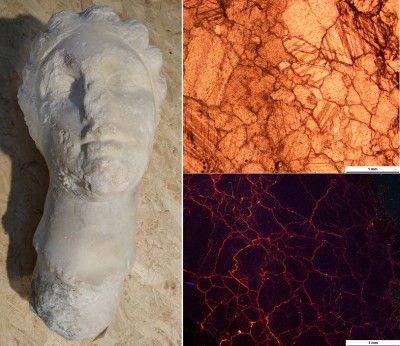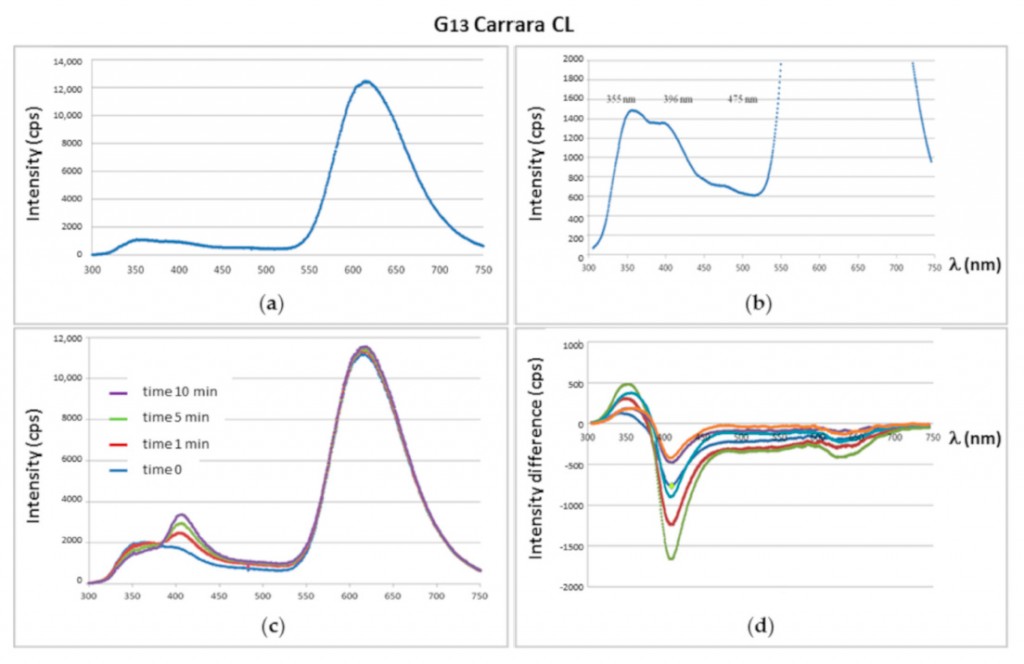
A new paper published in the journal Minerals presents the advances in the application of cathodoluminescence (CL) in the study and identification of white marbles used in the classical era.
The cathodoluminescence (CL) is an optical and electromagnetic phenomenon which occurs when an electron beam bombards matter, producing the emission of visible light. That is, emitting a luminescence.
This light varies depending on the chemical composition. In geology, it is often applied in combination with the petrographic microscope not only to distinguish between minerals but also to examine the internal structures of rocks, a key element in explaining the history of their formation.
With this new work, a step forward is made in the use of this technique and in the distinction between the different white marbles used in the Greco-Roman world. These materials are among the quintessential noble materials of the classical antiquity. It is not by chance that they were profusely used to make sculptures, sarcophagi, furniture, epigraphic inscriptions… as well as in the decoration of large monumental buildings or of villas and residences of social elites.
Paper authors are Ph. Blanc (emeritus professor at the Pierre and Marie Curie University – La Sorbonne), Pilar Lapuente (University of Zaragoza – ICAC associate researcher ) and Anna Gutiérrez Garcia-M., head of the Archeometric Studies Unit (UEA) at the ICAC.
This new paper presents two major milestones. On one side, one of the main limitations of optical CL is overcome, thanks to the quantification of the spectra and intensities of the luminescent response and the development of a specific methodology. On the other side, the first CL-quantitative database, resulting from the application of this technique, is now available to the scientific community.
The new method consists of preparing samples of the marble powder, and then place them on a plate specifically designed to be pressed and introduced into the scanning electron microscope (SEM) with an attached spectrometer. Thus, the specific spectra and the intensity of these spectra can be obtained for each of the samples.

Given the intrinsic instability of light emissions, numerous tests have been carried out under different experimental conditions, to obtain the greatest number of responses and to calibrate the protocol to obtain representative results.
Furthermore, this technique has been applied to a set of c. 500 samples of marbles from Italy (quarries of Carrara), Asia Minor (quarries of Göktepe, Afyon and Afrodisies) and Greece (quarries of the Pentelico, Tassos, Naxos, Paros and Proconeso) with extremely interesting results (especially once related to optical CL parameters) that confirm the great potential of quantitative CL as a complementary tool to current analyzes and with which to distinguish not only between the different white marbles but also between different quarries in the same extraction area.

This study is the continuation of a line of research initiated at the time by Ph. Blanc, one of the pioneers in the application of cathodoluminescence (CL) to the analysis of ancient marble. The technique was adopted by the ICAC’s Archaeometric Studies Unit, from a decade ago, as an essential part of the analytical protocol, thanks to the collaboration with Pilar Lapuente.
Thus, the UEA has become one of the world reference laboratories in this technique. Currently, the Unit team is working to include peninsular and Pyrenean marbles in this reference database, with the expectation of obtaining positive results in the short term.
Research results published in Minerals come from the research lines developed by ArPA research team (Archeometry and Artistic Productions) and, specifically, the following research projects:
- Officinae lapidariae Tarraconenses. Canteras, talleres y producciones artísticas en piedra de la Provincia Tarraconensis (I+D HAR2015-65319-P), led by Diana Gorostidi (URV-ICAC).
- El mensaje del mármol: prestigio, simbolismo y materiales locales en las provincias occidentales del imperio romano entre época antigua y alto-medieval a través del caso de Hispania y Aquitania, PGC2018-099851-A-I00 (MCIU/AEI/FEDER, UE), led by Anna Gutiérrez Garcia-M. (Ramón y Cajal researcher and head of the Archaeometric Studies Unit at the ICAC).





